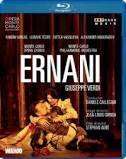|
Back
12/10/2017
Giuseppe Verdi: Ernani
Ramón Vargas (Ernani), Svetla Vassileva (Elvira), Ludovic Tézier (Don Carlo), Alexander Vinogradov (Don Ruy Gomez De Silva), Karine Ohanyan (Giovanna), Maurizio Pace (Don Riccardo), Gabriele Ribis (Jago),
Monte-Carlo Philharmonic Orchestra and Opera Chorus, Stefano Visconti (chorus master), Daniele Callegari (conductor), Jean-Louis Grinda (stage director), Isabelle Partiot-Pieri (set designer), Teresa Acone (costume designer), Laurent Castaingt (lighting designer), Stephan Aubé (film director)
Live recording: Opéra de Monte-Carlo, Monaco (April 2014) – 130’
Arthaus Musik 109344 (or Blu-ray 109345) – PCM Stereo, DD 5.1 – Picture format 16:9 – Region code: 0 – Booklet in English, French and German – Subtitles in English, German, French, Italian, Spanish, Japanese and Korean – (Distributed by Naxos of America)

   
This release of Verdi’s fifth opera is a curious mix of really fine elements with certain aspects that don’t quite make the grade.
On the good side: Daniele Callegari’s conducting captures Verdi’s energetic score, while the orchestra and chorus are fully up to the mark. Visually the production is very attractive. The first scene is played out before a backdrop painted to look like one of Paolo Uccello’s Battle of San Romano paintings, and subsequent characters seem to emerge from the painting. There is a tableau vivant aspect to the entire production, with sumptuous costumes and burnished lighting. At times mirrors reflect the stage action from above on to the backdrop. The stage picture is thus continually striking while some dramatic points (of which there are many in the overheated plot) are given short shrift.
As for the plot: it is busy and convoluted. It involves a noble woman, Elvira, being wooed by three men. She is engaged to an elderly uncle, Don Ruy Gomez De Silva (bass), and pursued by a youthful baritone, Don Carlo, who turns out to be the King of Spain and then becomes the Holy Roman Emperor, the great Carlo Quinto. However she is really in love with a “bandit”, Ernani, who turns out to be yet another nobleman, Don Juan of Aragon. The Spanish grandees are obsessed with their honour but their actions betray their self-serving natures. The action contains many confrontations and turnabouts, and vendettas are declared. To quote Julian Budden: “each illogical action follows logically from the one that precedes it.” The booklet omits a synopsis and following the subtitles still leaves one puzzled at times. The work is saved by the score with its alternating vigour and tenderness. The finale of Act III (where the action shifts abruptly from Spain to Charlemagne’s tomb at Aachen) builds to one of Verdi’s most glorious finales - and is well performed here.
As for the soloists: making a fine impression (and receiving the most ardent audience response) is baritone Ludovic Tézier as the king who has no compunction about pulling rank to his advantage. Ramòn Vargas has exactly the right spinto voice for the title role. Close-ups do him no favour, though, revealing a stolid presence; his performance probably came over better in the theatre than it does on camera. Alexander Vinogradov has a fine voice, but it has a youthful quality, lacking the menace that should emanate from Silva (after all, he is the opera’s bad guy).
The put-upon soprano role is central to the plot and she is given one of the best opening acts of any Verdi heroine, with a major scene that features the marvelous Ernani! involami. Unfortunately Svetla Vassileva is very uneven here and the cabaletta is effortful. Like Vargas, she might have been more effective in the theatre than on camera, where every glitch gets a close-up. At the same time, though, she is dramatically effective throughout the work.
Maurizio Pace makes a fine impression in the comprimario role of Don Riccardo, the king’s esquire.
It is hard to believe that when preparing the opera, Verdi considered creating either Ernani or Don Carlo for a mezzo-soprano en travesti. (More information from Budden’s essential The Operas of Verdi.)
While there is much to enjoy in a production which presents scenes that look like grand Renaissance paintings come to life, weak points persistently crop up. For fans of early Verdi it is still the real deal, although filmed alternatives might well have more consistent casting.
Michael Johnson
|